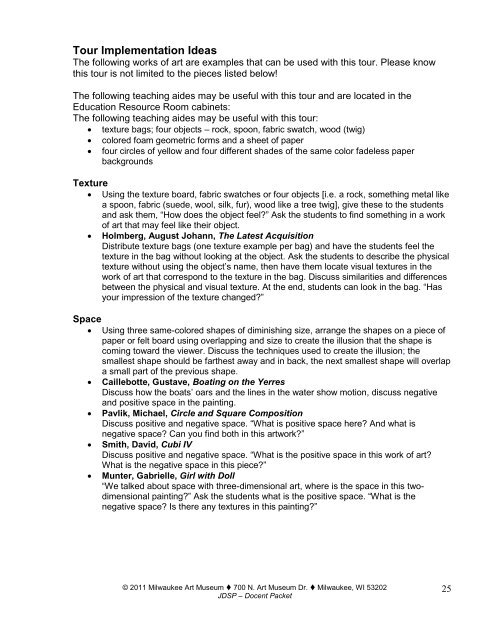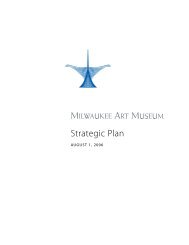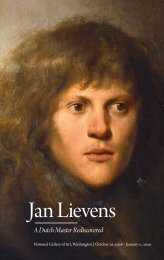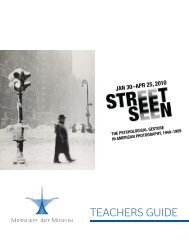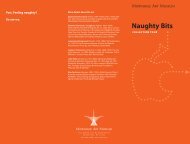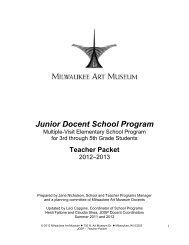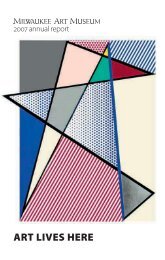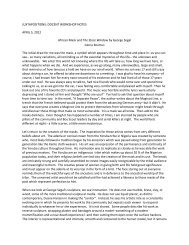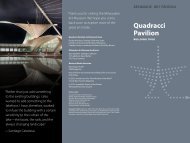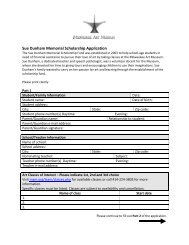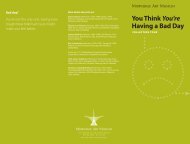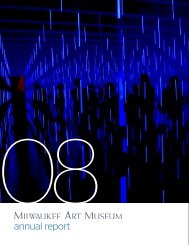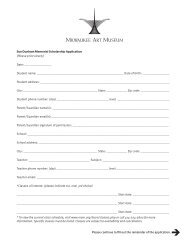Junior Docent School Program - Milwaukee Art Museum
Junior Docent School Program - Milwaukee Art Museum
Junior Docent School Program - Milwaukee Art Museum
Create successful ePaper yourself
Turn your PDF publications into a flip-book with our unique Google optimized e-Paper software.
Tour Implementation Ideas<br />
The following works of art are examples that can be used with this tour. Please know<br />
this tour is not limited to the pieces listed below!<br />
The following teaching aides may be useful with this tour and are located in the<br />
Education Resource Room cabinets:<br />
The following teaching aides may be useful with this tour:<br />
texture bags; four objects – rock, spoon, fabric swatch, wood (twig)<br />
<br />
<br />
colored foam geometric forms and a sheet of paper<br />
four circles of yellow and four different shades of the same color fadeless paper<br />
backgrounds<br />
Texture<br />
Using the texture board, fabric swatches or four objects [i.e. a rock, something metal like<br />
a spoon, fabric (suede, wool, silk, fur), wood like a tree twig], give these to the students<br />
and ask them, “How does the object feel?” Ask the students to find something in a work<br />
of art that may feel like their object.<br />
Holmberg, August Johann, The Latest Acquisition<br />
Distribute texture bags (one texture example per bag) and have the students feel the<br />
texture in the bag without looking at the object. Ask the students to describe the physical<br />
texture without using the object‟s name, then have them locate visual textures in the<br />
work of art that correspond to the texture in the bag. Discuss similarities and differences<br />
between the physical and visual texture. At the end, students can look in the bag. “Has<br />
your impression of the texture changed?”<br />
Space<br />
Using three same-colored shapes of diminishing size, arrange the shapes on a piece of<br />
paper or felt board using overlapping and size to create the illusion that the shape is<br />
coming toward the viewer. Discuss the techniques used to create the illusion; the<br />
smallest shape should be farthest away and in back, the next smallest shape will overlap<br />
a small part of the previous shape.<br />
Caillebotte, Gustave, Boating on the Yerres<br />
Discuss how the boats‟ oars and the lines in the water show motion, discuss negative<br />
and positive space in the painting.<br />
Pavlik, Michael, Circle and Square Composition<br />
Discuss positive and negative space. “What is positive space here? And what is<br />
negative space? Can you find both in this artwork?”<br />
Smith, David, Cubi IV<br />
Discuss positive and negative space. “What is the positive space in this work of art?<br />
What is the negative space in this piece?”<br />
Munter, Gabrielle, Girl with Doll<br />
“We talked about space with three-dimensional art, where is the space in this twodimensional<br />
painting?” Ask the students what is the positive space. “What is the<br />
negative space? Is there any textures in this painting?”<br />
© 2011 <strong>Milwaukee</strong> <strong>Art</strong> <strong>Museum</strong> 700 N. <strong>Art</strong> <strong>Museum</strong> Dr. <strong>Milwaukee</strong>, WI 53202<br />
JDSP – <strong>Docent</strong> Packet<br />
25


